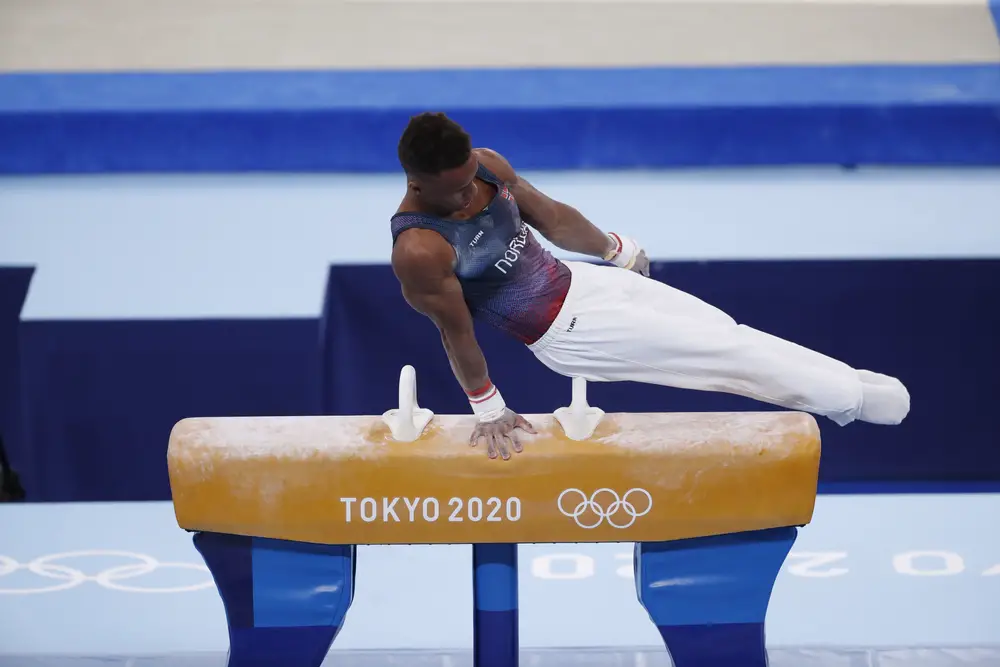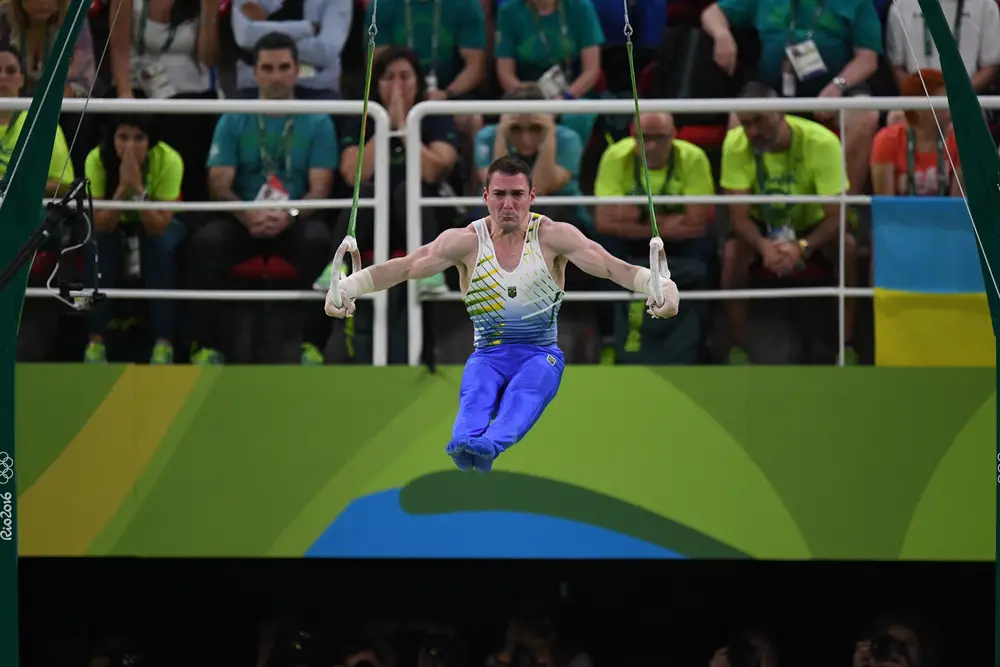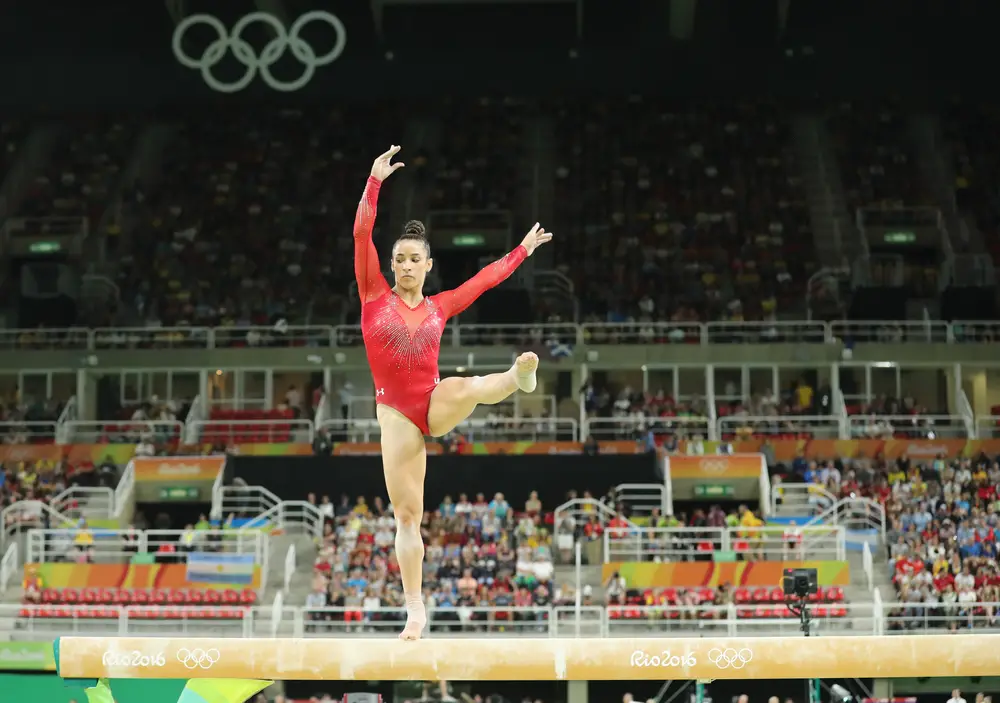The artistic gymnastics is a very popular sport all over the world, requiring a lot of strength, flexibility, balance and coordination from the athletes. In addition, it is performed on different apparatuses and needs to be perfect in order to enchant the judges.
With this in mind, we’ve created a artistic gymnastics glossary. Here, you’ll learn about the main terms used in the sport and what they mean. Understanding these words will help you have a better understanding of the sport as a whole.
Among the most commonly used terms in artistic gymnastics are words like landing, star, flic-flac, mortals, sequence, balance beam and many more. Each one is essential in the practice of the sport, so be sure to pay attention to their meanings, as it will also change the way you follow the competitions.

So let’s get to know the main terms in the artistic gymnastics glossary?
Open your Betano account and get up to 1,000 reais in bonuses.
Payments via PIX, live games and super odds!
Click here to open your account!
Artistic gymnastics glossary: complete list
- Amplitude
- Aparato (Aparelho)
- Aterrissagem
- Barra Fixa
- Barras Assimétricas
- Cavalo com Alças
- Chapa ou placa
- Entrada
- Estrela
- Execução
- Flic-Flac
- Grau de Dificuldade
- Grupo acrobático
- Mortais
- Passagem
- Sequência
- Trave de Equilíbrio
- Tsukahara
- Voo
- Yurchenko
Glossary of artistic gymnastics: learn more about the terms
Amplitude
This is the name given to the maximum extent of the movements performed by the gymnast. Wide, well-executed movements are the most valued by the judges, as they demonstrate the athlete’s flexibility and control.
Apparatus
The apparatus is a piece of equipment used by gymnasts to show off their skills. The main apparatuses in women’s gymnastics are the beam, floor, asymmetric bars and vault. In men’s gymnastics, there’s floor, pommel horse, rings, vault, parallel bars and fixed bar.
Landing
Landing is the action of landing on the ground after a jump or a series of aerial movements. It needs to be done carefully to earn more points.
Fixed Bar
An apparatus used in men’s gymnastics, consisting of a suspended horizontal bar where gymnasts perform acrobatic and swinging movements, demonstrating strength and skill.
Asymmetric bars
This is the name of an apparatus exclusive to women’s gymnastics which has two horizontal bars of different heights. The routines on the asymmetric bars include swinging movements, spins and jumps between the bars.
Horse with Straps
This apparatus is only used in men’s gymnastics. It has a structure with two handles where the gymnasts perform circular and scissor movements, requiring strength and coordination.
Plate
Movement in which the gymnast raises the legs forward or sideways in a handstand position or on the beam, keeping the body straight and aligned.
Entry
The entrance is the way in which the gymnast begins a series of movements on the apparatus, whether it’s a jump, a run or a specific preparation. A precise and well-executed entry can define the success of the routine.
Star
This is the name of the movement in which the gymnast performs a lateral twist, passing through a handstand position before returning to their feet. Also known as the “star without hands” when performed without the support of the hands.
Execution
Execution is the name given to the evaluation of how well the gymnast performs their movements, taking into account technique, form, range of motion, precision and more.
Flic-Flac
This is the name of the acrobatic movement in which the gymnast jumps from a standing position, spins backwards through a handstand and lands on their feet again. It is the basis for many combinations of movements on the floor and on the beam and is extremely important.
Degree of Difficulty
Measures the complexity of a movement or series of movements. Each stunt has a difficulty value that will contribute to the gymnast’s final score.

Acrobatic group
A set of acrobatic movements performed in sequence during a performance. These groups are evaluated on the basis of difficulty, execution and connection between the elements.
Mortals
Mortals are jumps in which the gymnast performs one or more complete turns in the air. They can be forward, backward or sideways somersaults, with different variations such as grouped, carpado or stretched.
Passage
Passage is the name of a series of consecutive movements performed in a single impulse, mainly in floor routines or on the balance beam.
Sequence
The sequence is the combination of several movements performed continuously, without any interruption. They are judged on the fluidity and complexity of the combined movements.
Balance beam
The balance beam is the name of the apparatus used in women’s gymnastics to perform series of movements that require great balance and precision. They measure 10 cm wide and 5 meters long.
Tsukahara
A type of jump in which the gymnast performs a 180-degree spin followed by a somersault. It is often used in vaulting competitions.
Flight
They characterize acrobatic movements performed in the air, such as jumps and spins. These elements are common in floor routines and on the asymmetric bars, demonstrating the gymnast’s acrobatic ability.
Yurchenko
The yurchenko is a type of jump in which the gymnast performs a flic-flac followed by a somersault after pushing off the vaulting table. This movement requires great power and technique from the athlete.

Artistic gymnastics glossary: complete list
- Amplitude
- Aparato (Aparelho)
- Aterrissagem
- Barra Fixa
- Barras Assimétricas
- Cavalo com Alças
- Chapa ou placa
- Entrada
- Estrela
- Execução
- Flic-Flac
- Grau de Dificuldade
- Grupo acrobático
- Mortais
- Passagem
- Sequência
- Trave de Equilíbrio
- Tsukahara
- Voo
- Yurchenko
Artistic gymnastics glossary
Did you like the glossary of artistic gymnastics? Artistic gymnastics is one of the sports that most challenges athletes’ physical limits, demanding not only concentration and precision, but also strength.
If you know the main terms in this list, you’ll be able to enjoy the sport much more, as you’ll be able to understand what’s going on. What’s more, you can predict the athletes’ next moves and understand the importance of each stunt.
If you liked this content, take the opportunity to continue visiting the site and check out other news, lists and much more about artistic gymnastics and other sports. Your comments are also very welcome!



